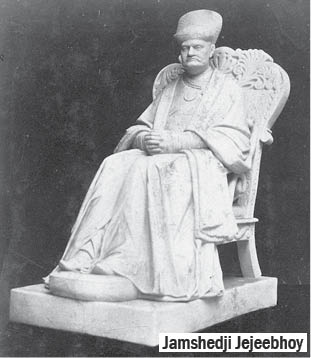 The contribution of Parsis to the socio-economic development and welfare of the country is too wide and varied for justice in a short treatise. The Wadias have built schools, colleges and hospitals, the Petits too have built schools, hospitals, sanatoriums and dharamshalas. Whenever and wherever wealth has been generated by Parsis, its judicious use for the weal to humanity has followed close behind. There are important lessons to be drawn from the history of India’s industrial revolution pioneered by Parsis, and the value system they laid down is a beacon of light for generations to come.
The contribution of Parsis to the socio-economic development and welfare of the country is too wide and varied for justice in a short treatise. The Wadias have built schools, colleges and hospitals, the Petits too have built schools, hospitals, sanatoriums and dharamshalas. Whenever and wherever wealth has been generated by Parsis, its judicious use for the weal to humanity has followed close behind. There are important lessons to be drawn from the history of India’s industrial revolution pioneered by Parsis, and the value system they laid down is a beacon of light for generations to come.
Our sagacious ancestors wisely believed that wealth and its acquisition is positive and good, provided it is acquired by righteous means and used for good purposes. They also believed in the trusteeship of wealth – and how injustice could be taken out of wealth if used creatively and for the good of humanity. Fair and ethical business practices also happen to be the hallmark of Parsi business houses. In India, and for that matter, the world, the word ‘Parsi’ is synonymous with charity and enterprise.
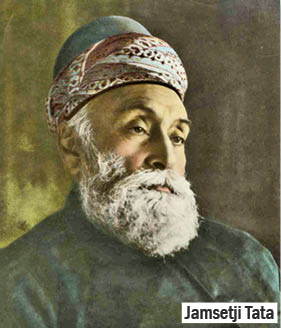 The driving force behind a Parsi’s spirit of enterprise and charity is his religious ethos. From a religious point of view, Parsis consider poverty and suffering as an affliction of evil. To remove poverty, want, disease and human suffering is not only a religious duty and part of Parsi culture, but, an act of spiritual merit, depriving ‘evil’ of sustenance.
The driving force behind a Parsi’s spirit of enterprise and charity is his religious ethos. From a religious point of view, Parsis consider poverty and suffering as an affliction of evil. To remove poverty, want, disease and human suffering is not only a religious duty and part of Parsi culture, but, an act of spiritual merit, depriving ‘evil’ of sustenance.
If Christ asked his followers to love their neighbours, Zarathushtra asked his followers to attain happiness by making others happy. (Yasna 43.1). Many religious traditions, directly or indirectly, have looked down upon wealth and its acquisition. Parsis, on the other hand, consider wealth to be fundamentally positive, provided it is acquired through righteous means and used for righteous purposes.
Jamsetji Tata and his successors firmly believed that one way to take the injustice out of riches is to dedicate riches to the service of the people. The wealth garnered by the House of Tatas established for India, the institution that built the First Atomic Reactor in Asia, the First Cancer Hospital in India, the First Centre for the Performing Arts and the Institute For Fundamental Research.
The patriarch of the Tata family, Jamsetji, lived in an age when philanthropy was its own reward – tax rebate for charitable donations was unknown then. The House of Tatas has also been responsible for creating a new industrial culture in India. At a time when captains of industry in Europe and America were exploiting their workers, Jamsetji thought of their upliftment. He cared to give them filtered water, sanitary hutments, cheap food grains, medical facilities, provident fund and accident insurance. While most captains of industry believed that man is meant to serve industry, Jamsetji believed that industry was meant to serve man. Even today, Tata Steel looks after over 300 villages in the vicinity of Jamshedpur and the far-flung mines of Tata Steel. There are many firsts in labour welfare as far as Tata Steel is concerned. For example, TISCO introduced eight hours of work in 1912 and free medical aid in 1915 which was enforced by law (Factories Act and Employees State Insurance Act) only in 1948. TISCO launched Profit Sharing Bonus in 1934 which was enforced by the Bonus Act only in 1965.
Jamsetji Tata was, no doubt, a visionary and the Father of building a Modern Industrial India. However, the Prince of Philanthropists is, without doubt, the Merchant Prince, Sir Jamsetjee Jejeebhoy – the first Indian Knight and Baronet. The extent of his philanthropy is too vast, wide and varied to be compared with any other philanthropist. His contribution to public works and charities between 1822 – 1859 aggregated Rs.24,59,736/-. It is interesting to note that out of this staggering sum (for that period of time), less than 50% went for the Parsi community. Acts of benevolence were as natural to Jamsetjee as breathing; besides feeding the poor, clothing the needy, sinking wells for the thirsty, he built bridges and causeways to save precious human lives, dharamshalas and shelters for the homeless, shelters for the infirm and forsaken animals and the first hospital for civilians in Bombay – an institution where, even today, the poor and needy are treated totally free or at very nominal rates. At a time when primary education was lacking in India, Jamsetjee gave money to establish a School of Arts. Even today, it is the biggest school of its kind in the East.
Jamsetjee believed that true philanthropy should be aimed at making its recipients self-reliant and self-respecting and capable of earning their way through life by doing an honest day’s work. Educational facilities and employment opportunities would alone ensure this. His major philanthropic works had one aim – to train and equip men and women for life – to help them help themselves. He did build and endow fire temples. But he also built ‘temples of learning’ – schools, seminaries and schools of art.
.
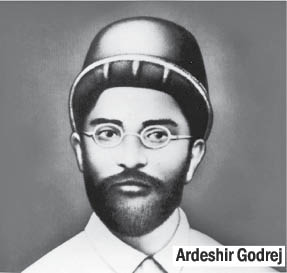 The House of Godrej is another household. You open the fridge to grab some food and it is likely to be Godrej. You open the steel cupboard to get your clothes or open your safe to get some money and it is likely to be Godrej! The House of Godrej has completed more than a hundred years in Industry. However, more than its products, one vision shines on with the brightness its originator intended – the concept of the ‘Trusteeship of Wealth’. It was begun by the founder, Ardeshir Godrej, through a spontaneous gesture of a Rs.3 lakhs donation in 1926 to the Tilak Fund for the upliftment of Harijans and acknowledged by Mahatma Gandhi as “the biggest contribution he had received for the cause.”
The House of Godrej is another household. You open the fridge to grab some food and it is likely to be Godrej. You open the steel cupboard to get your clothes or open your safe to get some money and it is likely to be Godrej! The House of Godrej has completed more than a hundred years in Industry. However, more than its products, one vision shines on with the brightness its originator intended – the concept of the ‘Trusteeship of Wealth’. It was begun by the founder, Ardeshir Godrej, through a spontaneous gesture of a Rs.3 lakhs donation in 1926 to the Tilak Fund for the upliftment of Harijans and acknowledged by Mahatma Gandhi as “the biggest contribution he had received for the cause.”
The initiation of philanthropy by Ardeshir was strengthened by his brother, Pirojsha, who made it a corporate principle for the Godrej group. He anticipated labour legislations by providing housing, schooling (epitomized today in the Godrej Udayachal School) medical aid and paid leave to workers. Environmental and social concerns were equally vital to his vision and to the vision of his sons, among whom, the youngest, Naval, set up the Foundation for Medical Research and other pioneering institutions.
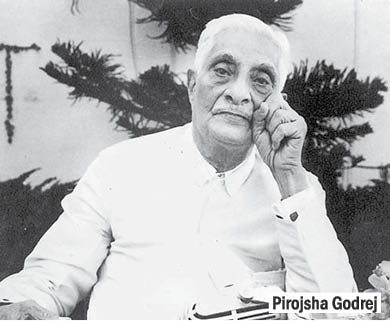 The Pirojsha Godrej Foundation, which was established in 1972, birthed the Godrej Baug at Napeansea Road, Red Cross Disaster Centre at Vikhroli and P. Godrej Memorial Wing at Breach Candy Hospital.
The Pirojsha Godrej Foundation, which was established in 1972, birthed the Godrej Baug at Napeansea Road, Red Cross Disaster Centre at Vikhroli and P. Godrej Memorial Wing at Breach Candy Hospital.
.
The Wadias were master ship-builders of Surat, which was a very important sea port on the west coast of India. The Portuguese, Dutch, French and British maintained trading centers in Surat from the fifteenth century onwards. Since all trade was done by sea, the shipping industry started to flourish. The foreign traders knew Lovji Nusserwanji Wadia for the high standards he maintained in shipbuilding workmanship. The British East India Company also secured the services of Lovji for building docks and ships in Bombay in 1736. The Bombay dry-dock, the first dry-dock in Asia, was built by Lovji and his brother Sorabji in 1750. Bombay began being considered a viable trading port for all ships from the West and East thanks to the Wadia brothers.
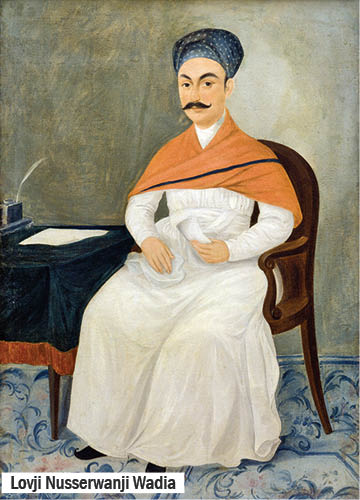 Lovji has rightly been called the founder of the shipping industry in Bombay. His sons, Maneckji and Bomanji, built on his reputation of integrity, industry and ability. Seven generations of Wadia master-shipbuilders have constructed ships in Bombay that have plied the seven seas from the shores of the New World to the ancient shores of the China Seas. Many ships were built for the Indian and British Navy. When their connection with the Bombay Dockyard ended in 1913, the Lovji Wadia family had left a legacy of ships, from sloops to schooners, merchant ships and man-o-wars, cutters and clippers, frigates, water boats and steamships – over 400 ships!
Lovji has rightly been called the founder of the shipping industry in Bombay. His sons, Maneckji and Bomanji, built on his reputation of integrity, industry and ability. Seven generations of Wadia master-shipbuilders have constructed ships in Bombay that have plied the seven seas from the shores of the New World to the ancient shores of the China Seas. Many ships were built for the Indian and British Navy. When their connection with the Bombay Dockyard ended in 1913, the Lovji Wadia family had left a legacy of ships, from sloops to schooners, merchant ships and man-o-wars, cutters and clippers, frigates, water boats and steamships – over 400 ships!
The one ship that the Wadias built and of most historic significance for Parsis is the HMS Minden. A young American lawyer, Francis Scott Key was sent on board the British ship ‘Minden’, in Chesapeake Bay to negotiate the release of a friend who had been captured after the defeat of the US forces in Maryland. Francis was detained on the ship overnight while the British attacked Baltimore. “At the dawn’s early light” amidst the “rockets’ red glare”, he saw the American flag still flying high over Fort McHenry which inspired him to hurriedly scribble on an envelope a poem, that was to become the Star-Spangled Banner, national anthem of United States of America! Just imagine, the American National Anthem was written on a ship built by a Parsi!
In 1834, Ardeshir Cursetji Wadia was the first to introduce gas to Bombay. He became the first Indian Fellow of the Royal Society of London in 1841.
Nowroji Nusserwanji Wadia proved his engineering skills by establishing the well-known Bombay Dying & Manufacturing Co. for manufacture of textiles in 1879. As a member and chair of various government and educational bodies, he introduced programs for better schooling; introduced the kindergarten system of education; advocated physical training for boys and girls; better administration of hospitals etc. His munificence made many socio-economic programs possible.
Naoroji’s sons, Cusrow and Ness, expanded the textile business and were known as much for their philanthropy as for their business acumen. In the 1920s, Ness established a wireless service, forerunner of the telephone, the India Radio and Communication Company, linking India and Britain for the first time.
Motlibai Maneckji Wadia married her cousin Maneckji, but, was widowed at the age of 26. She gave large sums of money for maintenance of fire temples and built one in Bombay in memory of her father Jehangirji. In 1894, she rebuilt the Udvada Atash Behram and set aside sums for the future upkeep. She established dispensaries and in particular, the Bai Motlibai Obstetric Hospital. Land and money was given to orphanages and donations flowed freely for emergency relief of citizens due to fire, famine and flood disasters.
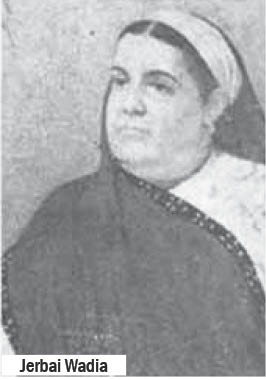 Jerbai Nusserwanji Wadia was a pioneer of low-cost housing complexes (Baugs). The first Baug she built was Nowroz Baug in memory of her husband. In 1917 Jerbai established the Naoroji N. Wadia Building Trust Fund which helped in building the Rustom Baug and Jer Baug. Her sons Cusrow and Ness continued her work and built Cusrow Buag and Ness Baug. She donated generously to help build several clinics and hospitals. After her death, her sons built the Bai Jerbai Wadia Hospital for Children in her memory.
Jerbai Nusserwanji Wadia was a pioneer of low-cost housing complexes (Baugs). The first Baug she built was Nowroz Baug in memory of her husband. In 1917 Jerbai established the Naoroji N. Wadia Building Trust Fund which helped in building the Rustom Baug and Jer Baug. Her sons Cusrow and Ness continued her work and built Cusrow Buag and Ness Baug. She donated generously to help build several clinics and hospitals. After her death, her sons built the Bai Jerbai Wadia Hospital for Children in her memory.
.
.
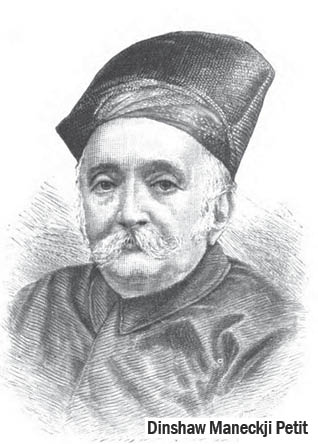 Petit means ‘small’ in French. However, the family’s spirit of enterprise is as large as their zest for philanthropy. Almost every Parsi must have been either a patient or a visitor to see a friend or relative at the BD Petit Parsi General and many a Parsi girl must have been a student at the Bai Avabai Petit School at Bandra or the J B Petit School in South Mumbai, situated right next to the JN Petit library.
Petit means ‘small’ in French. However, the family’s spirit of enterprise is as large as their zest for philanthropy. Almost every Parsi must have been either a patient or a visitor to see a friend or relative at the BD Petit Parsi General and many a Parsi girl must have been a student at the Bai Avabai Petit School at Bandra or the J B Petit School in South Mumbai, situated right next to the JN Petit library.
Nasserwanjee Cowasjee Bomanjee was agent to French vessels arriving at the port of Bombay as well as to the East India Company’s vessels. He was a man of small build and the French often referred to him as ‘petit’. The nick-name stuck to him and was adopted as the family name by successive generations.
A patriot, pioneer and benefactor, Sir Dinshaw Manockjee Petit, first Baronet, started life as a broker and later turned to manufacturing. He was the first to introduce looms for a weaving mill in the whole of India in 1855. He was also the pioneer of the dyes industry. Between 1870 and 1875, he and his brother, Nusserwanji, owned 17 mills. Sir Dinshaw became a Trustee of the Bombay Parsee Punchayet and Sir JJ Parsee Benevolent Institution at the young age of 37. He served as Trustee for 41 years, possibly as the longest serving trustee in the history of the BPP.
As a great captain of industry, Dinshaw also became a Director of the Bank of Bombay, the Bombay Fire Insurance Company and the Hyderabad Spinning & Weaving Company. He was the Founder and Trustee of the Persian Zoroastrian Amelioration Fund, its Chairman from 1876 and its Treasurer from 1885. Due to his perseverance, from 1861 to 1882, the dreadful Jizya tax was abolished, bringing relief to destitute Irani Zoroastrians in Iran.
In 1883 he donated his maternal grandfather, Seth Jeejeebhai Dadabhai’s large estate of about 40,500 sq. yards at Parel to the Society for Prevention of Cruelty to Animals (SPCA). The land was donated for starting a hospital for treatment of suffering animals. Lord Dufferin, the Viceroy of India, inaugurated the hospital and named it the Bai Sakarbai Dinshaw Petit Hospital for Animals on 10th December 1884. The Bai A F Petit School at Bandra, the J N Petit Institute, the J N Petit School at Pune, Bai R F D Panday School, the B D Petit Parsee General Hospital, and the Framjee Dinshaw Petit Sanatorium at Cumballa Hill are just some of the institutions established through the munificence of the Petit family.
.
There is much to be proud of and even more to be grateful for. Most important of all, these pioneers of industry have left a legacy of values – values of honesty, enterprise, sharing, concern, development and progress. These, more than material wealth, is the real contribution of some of the most well-established Parsis, to India.
- Moon And Moods - 22 February2025
- The Joy Of Giving - 15 February2025
- Celebrate A Joyful Week Of Love - 8 February2025
